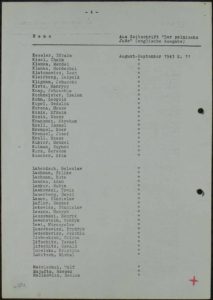Last spring, I contacted the Holocaust Memorial Museum (USHMM) in DC, in hopes of tracking down some family records through the International Tracing Service (ITS), a German archive containing ~3o million WWII/Nazi-era documents. I submitted five separate inquiries, one for each of the Kurc siblings. I never heard back, and after a month, I marked ITS on my list of resources as “explored.”
And then—almost a year later—I woke up to an inbox full of news from a gentleman by the name of Bashi at USHMM’s Holocaust Survivors and Victims Resource Center. Bashi apologized for not being able to locate any ITS records for my grandfather (unsurprising, as he was living in France at the outbreak of the war, and fled shortly after for Brazil)—but my inquiries, it turns out, had churned up a slew of documents for each of Addy’s siblings—one for Genek, five for Halina, six for Mila, and a whopping eight for Jakob. Overwhelmed with gratitude, I thanked Bashi for his help. Then I dug into his findings.

A list of Polish Jews serving with the Polish Army in Tehran, dated August-September 1943, Genek’s name included
For Genek, Bashi had discovered the name “Gerszon Kurc” on a list of Jewish refugees serving with the Polish Army in Tehran. He found Mila’s name on a list of Polish Jews employed in Warsaw in 1945. Jakob and Maryla were listed among hundreds of refugees who passed through the infamous Bergen-Belsen concentration camp in 1946 (post-war). One document revealed that Halina had been confined to a prison in Krakow from August 1944 until January 1945 (when Soviet forces entered the city).
It took me weeks to translate and decode each of the records (20 in all). By the time I was finished, I’d filled several gaps in my family’s timeline. But I was also left scratching my head, suddenly consumed with a whole new set of questions.

An inquiry made to the ITS indicating that Halina was imprisoned at the infamous Montepulpich Gestapo prison in Krakow for 5 months, until freed by the Russians in January of 1945
What kind of will did it take, I wondered, for Maryla to walk through the gates to Bergen-Belsen, when she’d lost her parents to Treblinka just two years before? And how did Mila find work as a Jew in Warsaw? I was under the impression she’d gotten by with falsified Aryan papers, but the work records Bashi sent were entitled Wykaz Alfabetyczny Zydow Polskich: an Alphabetized List of Polish Jews. And what was it like for Halina, at 27 years old, to spend nearly half a year in Krakow’s notorious Montelupich Prison—one of the “most terrible Gestapo prisons in Poland?” (I’ve asked Krakow’s Commission for the Prosecution of Crimes against the Polish for more details about her incarceration.)
Such is the nature, I’ve learned, of ancestry research: information garnered can be as mind boggling as it is revelational (e.g., I was aware Halina spent some time in jail, but now I know which jail, and for how long…that said, I’ll only ever be able to imagine what was going through her head during those five heinous months at Montelupich). But that’s okay. Because thanks to Bashi’s findings, my story is more complete. And because as a writer, filling in the missing details is, well, part of the gig.

A page from a list of Jews who passed through the Bergen-Belsen concentration camp in 1946, Jakob and Maryla (listed as “Maria”) at far left
Interested in Researching Your Family’s Holocaust Records?
If you’d like to try to track down your own family’s Holocaust records, I highly recommend contacting the International Tracing Service. You can submit an inquiry here, through the US Holocaust Museum. Keep in mind it may be months before you hear back. You can also try searching USHMM’s Holocaust Survivors and Victims Database, JewishGen (powered by Ancestry.com), Yad Vashem, the American Jewish Joint Distribution Committee, and the The Holocaust and War Victims Tracing Center (managed by the American Red Cross). For more advice on researching your family history, check out my page on Ancestry Search Tips.